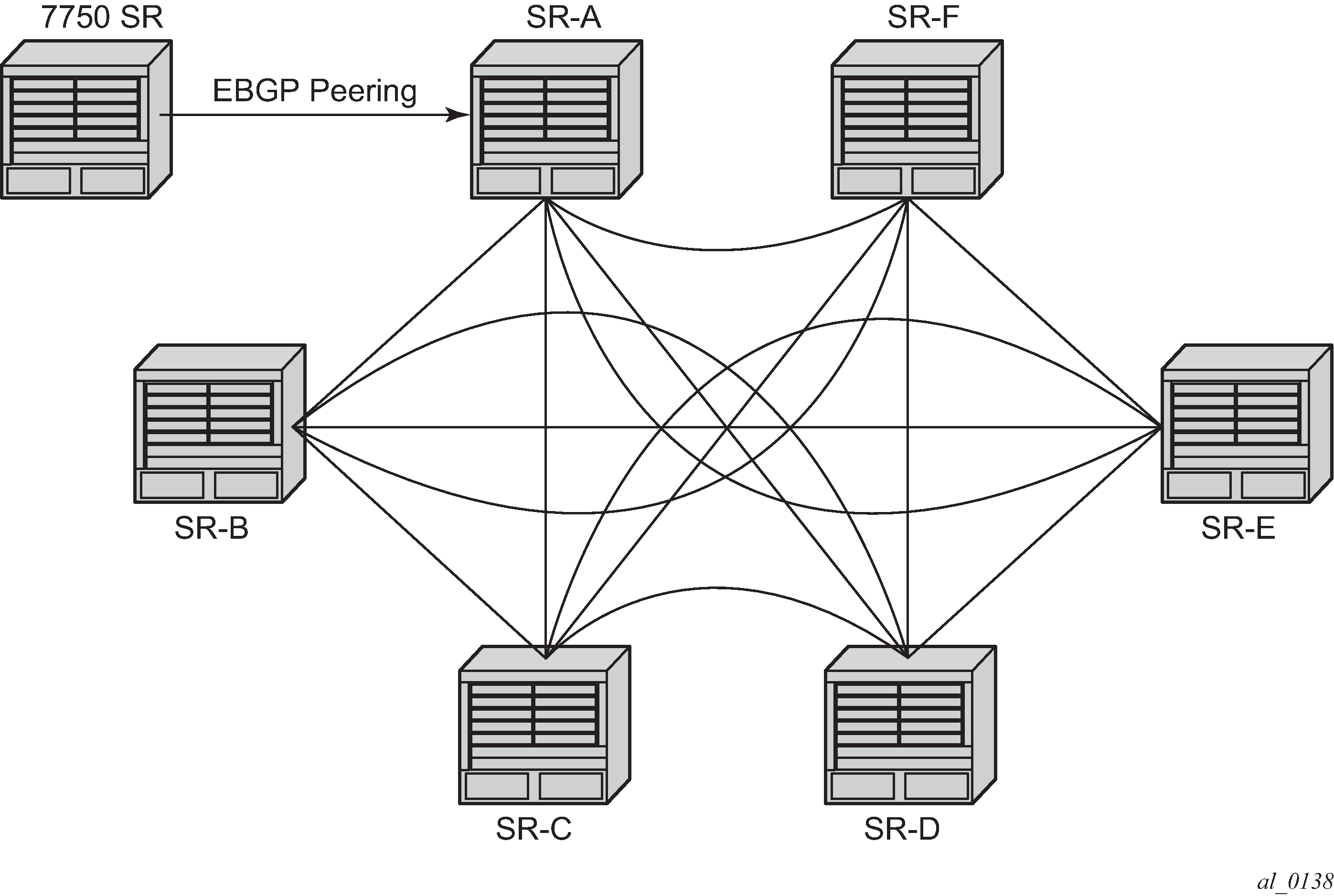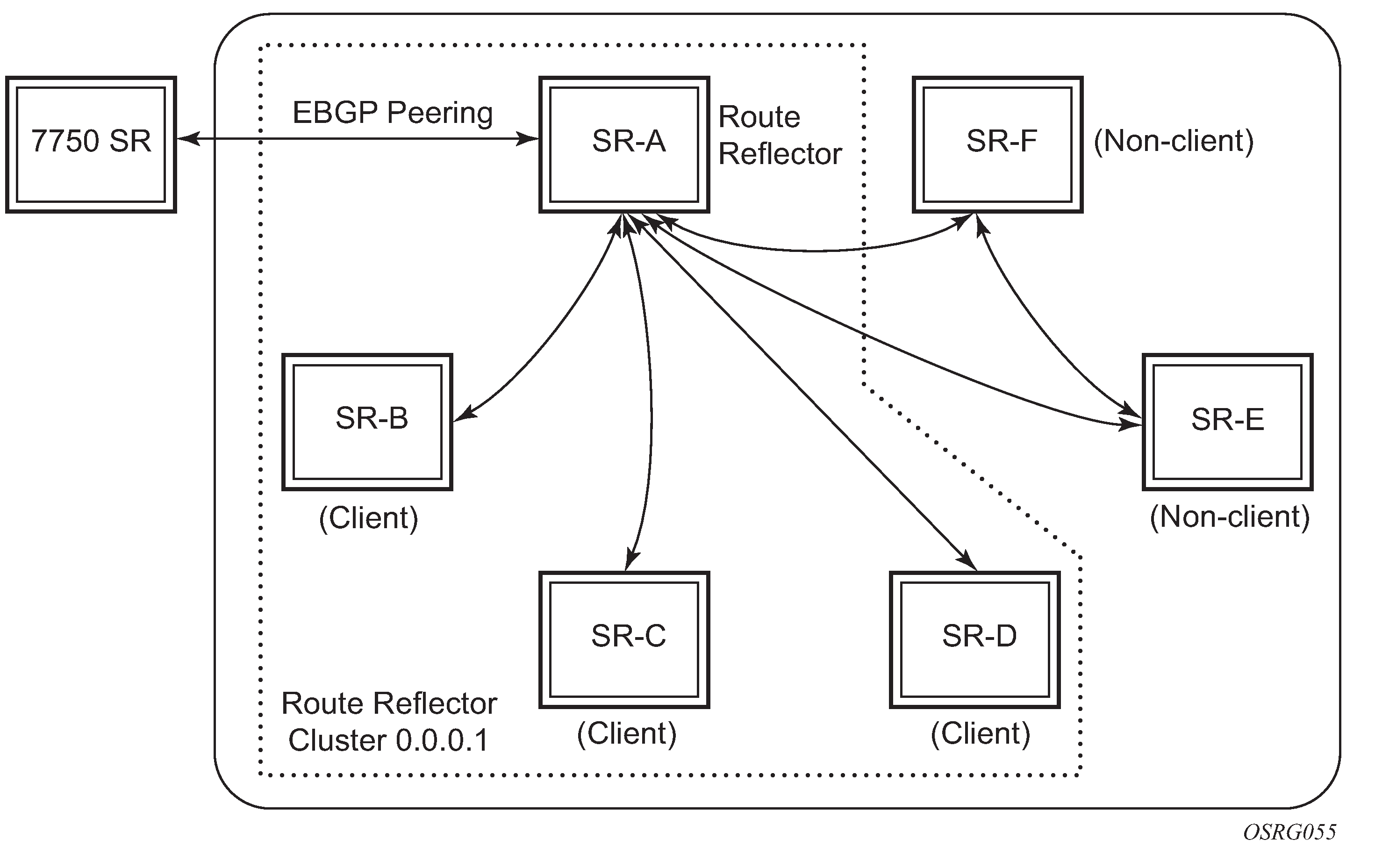In a standard BGP configuration, all BGP speakers within an AS, must have full BGP mesh to ensure that all externally learned routes are redistributed through the entire AS. iBGP speakers do not re-advertise routes learned from one iBGP peer to another iBGP peer. If a network grows, scaling issues could emerge because of the full mesh configuration requirement. Instead of peering with all other iBGP routers in the network, each iBGP router only peers with a router configured as a route reflector.
Route reflection circumvents the full mesh requirement but maintains the full distribution of external routing information within an AS. Route reflection is effective in large networks because it is manageable, scalable, and easy to implement. Route reflection is implemented in autonomous systems with a large internal BGP mesh to reduce the number of iBGP sessions required within an AS.
The 7210 SAS can be configured only as route reflector clients. Only the client functionality of a route reflector described here is available for use with the 7210 SAS. The route reflector server-side functionality cannot be used on the 7210 SAS.
A large AS can be sub-divided into one or more clusters. Each cluster contains at least one route reflector which is responsible for redistributing route updates to all clients. Route reflector clients do not need to maintain a full peering mesh between each other. They only require a peering to the route reflectors in their cluster. The route reflectors must maintain a full peering mesh between all non-clients within the AS.
Each route reflector must be assigned a cluster ID and specify which neighbors are clients and which are non-clients to determine which neighbors should receive reflected routes and which should be treated as a standard iBGP peer. Additional configuration is not required for the route reflector besides the typical BGP neighbor parameters.
The following figure shows a simple full-mesh configuration with several BGP routers. When SR-A receives a route from SR-1 (an external neighbor), it must advertise route information to all of its iBGP peers (SR-B, SR-C, SR-D, and so on). To prevent loops, iBGP learned routes are not re-advertised to other iBGP peers.

When route reflectors are configured, the routers within a cluster do not need to be fully meshed. The preceding figure shows a fully meshed network and Figure: BGP configuration with route reflectors shows the same network but with route reflectors configured to minimize the iBGP mesh between SR-A, SR-B, SR-C, and SR-D. SR-A, configured as the route reflector, is responsible for redistributing route updates to clients SR-B, SR-C, and SR-D. iBGP peering between SR-B, SR-C and SR-D is not necessary because even iBGP learned routes are reflected to the route reflector’s clients.
In the following figure, SR-E and SR-F are shown as non-clients of the route reflector. As a result, a full mesh of iBGP peerings must be maintained between, SR-A, SR-E and SR-F.

A route reflector enables communication between the clients and non-client peers. Clients of a route reflector do not need to be fully meshed but non-client peers need to be fully meshed within an AS.
A grouping, called a cluster, is composed of a route reflector (or a redundant pair of route reflectors configured with the same cluster-id) and its client peers. Each route reflector is assigned a cluster ID and this defines the cluster that it and its clients belong to. Multiple route reflectors can be configured within a cluster for redundancy. A router assumes the role as a route reflector by configuring the cluster cluster-id command. No other command is required unless you want to disable reflection to specific clients.
When a route reflector receives an advertised route, it selects the best path. If the best path was received from an eBGP peer then it is typically advertised, with next hop unchanged, to all clients and non-client peers of the route reflector. If the best path was received from a non-client peer then it is advertised to all clients of the route reflector. If the best path was received from a client then it is advertised to all clients and non-client peers.